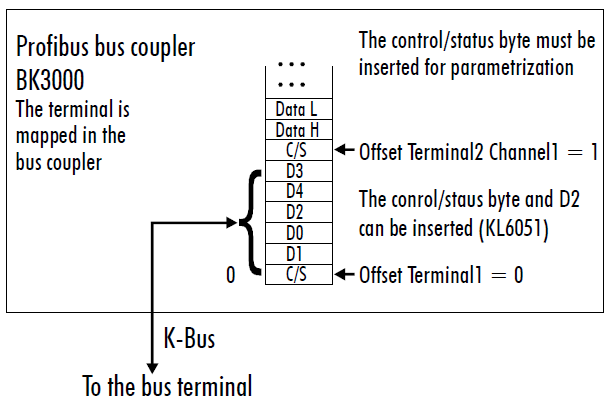KL6051 - Terminal configuration
The terminal can be configured and parameterized via the internal register structure.
Each terminal channel is mapped in the Bus Coupler. Depending on the type of the Bus Coupler and the mapping configuration (e.g. Motorola/Intel format, word alignment etc.) the terminal data are mapped in different ways to the Bus Coupler memory.
To parameterize a terminal, it is necessary to map the control/status byte.
BK2000 Lightbus Coupler
In the BK2000 Lightbus Coupler, the control and status byte is mapped in addition to the data bytes. This is always in the low byte on the offset address of the terminal channel. With the KL6051, 6 bytes of data (5 bytes user data and 1 byte control/status) are exchanged with the controller.

BK3000 PROFIBUS Coupler
With the BK3000 Profibus Coupler, the mapping of the KL6051 in the Bus Coupler is set in the master configuration software. The diagram shows the mapping for 6 bytes of input data and 6 bytes of output data.

BK4000 Interbus Coupler
By default, the BK4000 Interbus Coupler maps the KL6051 with 4 bytes of input data and 4 bytes of output data. Parameterization via the fieldbus is not possible. The KS2000 software is required if the terminal is to be reparameterized.

Other Bus Couplers and further information
Further information about the mapping configuration of Bus Couplers can be found in the Appendix of the respective Bus Coupler manual under Master configuration.
The chapter on Mapping in the Bus Coupler contains an overview of possible mapping configurations, depending on the configurable parameters.
 | Parameterization with KS2000 The KS2000 configuration software can be used for parameterizations via the serial interface of the Bus Coupler, independent of the fieldbus system. |